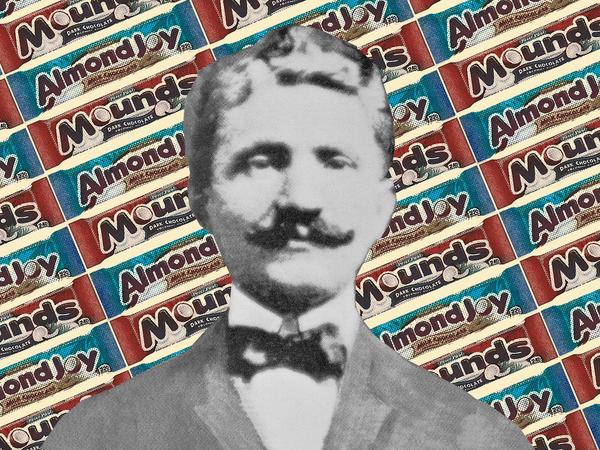
How Armenian immigrants built an American candy empire

This is a story about how six Armenian immigrants escaping looming atrocities in the Ottoman Empire, came to America and created a candy empire in small town Connecticut, winning a permanent place in confectionary history forever. It is a story about immigration, ingenuity and the quintessential American dream, except its coated in chocolate and filled with shredded coconut, of course.
Armed with a huge bout of naive ambition, Peter Halajian’s intrepidity gave America two of its most “indescribably delicious” inventions: The Mounds bar and Almond Joy.
Yes, an Armenian-American immigrant is ultimately responsible for the single most contagious TV commercial jingle: “Sometimes you feel like a nut, sometimes you don’t.”
Born in 1873 in Turkey according to United States Census records, Peter Halajian set off for America in 1890, just as large scale hostilities were increasing in Anatolia against the Ottoman Empire’s Armenian community, in what later became known as the Hamidian Massacres.
As he settled in New Haven, Connecticut, Halajian found work in the rubber factories of a small community called Naugatuck. He realized that the local towns people were having difficulties in pronouncing his last name (sound familiar?), so he made the decision to legally change it to Peter Paul.
But ever the entrepreneurial and stubborn Armenian, Paul wanted to make a name for himself running his own business, instead of working for someone else. After he finished his day at the rubber factory, he’d sell fruits and confectionary goods with his daughters by his side. There was enough fanfare around his products that he decided to open his own shop in 1897 selling ice cream, sweets and an assortment of fruits.
“Although fruit is scarce and hard to get, Peter Paul has a large supply and the prices asked are very reasonable,” read a 1901 newspaper ad.
Though he had reached an unprecedented level of success, Paul’s dreams were bigger and sweeter than just a fruit and confectionary shop in small town Connecticut.
So in 1919, he gathered five of his closest Armenian friends who had also emigrated to the U.S. to escape the Armenian Genocide, and persuaded them to get into the candy business.
George Shamlian, Cal Kazanjian, Jacob Chouljian, Harry Kazanjian and Jacob Hagopian agreed. The Peter Paul Candy Manufacturing Company was born.
It was Shamlian, a chemist, who came up with the recipe in 1920 for what was to be known as the Mounds Bar – a dark chocolate bar with a creamy coconut filling named after the way it looked.

Just as the company was growing, Peter Paul Halajian passed away due to ill health in 1927. His brother-in-law Cal Kazanjian soon took over.
Despite the fact that they were competing with other emerging candies on the market like the Oh Henry! bar and Milky Way, Peter Paul Manufacturing continued to expand – moving from cramped quarters to a big candy factory employing over 500 people. The company decided quickly that it wasn’t interested in competing with other candy manufacturers by coming up with new products, but sticking to what it was already doing well: making the best coconut bars anybody could buy for 5 cents. Its products were generally sold through brokers who worked on commission.
“Mr. Kazanjian used to carry a little box of ‘Mounds’ around with him,”wrote reporter Wesley S. Griswold in a 1935 article in the Hartford Courant, “When he entered the broker’s office, he would take one of the coconut bars out of his pocket, remove its tinfoil cloak, deftly break the chocolate-covered confection and offer the broker a taste. Invariably this routine was awarded with an order.”

During the depression, the company took a risk and doubled the size of the Mounds bar at a time when many others were cutting back on products. They also repackaged the bar in cellophane rather than tinfoil to save money without compromising the quality of their product.
The strategy was a massive hit. But by the early 1940s, another series of events forced the company to take another direction. Literally.
When the Japanese invaded and occupied the Philippines – where Peter Paul was sourcing its entire supply of coconut – the company turned to the Caribbean. In order to evade German submarines, they used smaller, more discreet boats to transport coconuts – their most important raw material – to Florida.
Though it had its international equivalents, the Mounds bar never appeared in the overseas market itself – except for one very unusual incident involving a Nazi prisoner of war extradited to the U.S. in 1945.

“German General Is Found to Be in Possession of Peter Paul Mounds,” read the headline in 1945
The general, whose name remained unknown, was found to be in possession of the iconic red box after being searched by American officials when he arrived in New York, on his way to a prisoner of war camp.
“Sticking out like a sore thumb among the array,” the Naugatuck Daily News wrote, was [sic] A BOX OF PETER PAUL MOUNDS!!!!”
One possible explanation for why a Nazi general would be in possession of an American candy bar could be encounters with Peter Paul’s biggest customer at the time. The company was almost exclusively producing Mounds for the army, instead of civilians. Because the United States military regarded chocolate as both a morale boost and high-energy treat for personnel, Peter Paul was supplying 5 million Mounds bars to the U.S. army during WWII.
The Centralia Enterprise and Tribune in Wisconsin soon called the firm the “largest manufacturer of coconut candy in the world.”
By this point, the company had achieved the kind of success that seemed impossible for a group of immigrants who came to America with nothing. But Peter Paul had more work to do.
In 1946, they added a new product that would rival the Mounds bar and make the company one of the most successful candy manufacturers of the 20th century: Almond Joy.

Made with milk chocolate, coconut cream filling and a toasted almond on top unlike the plainer and darker Mounds, the Almond Joy turned out to be its predecessor’s biggest rival and made Naugatuck synonymous with chocolate – instead of rubber factories – forever.
Having long been considered candy manufacturing pioneers in the advertising world, Peter Paul recruited marketing jingle maven Leon Carr who came up with the lyrics,”Sometimes you feel like a nut, sometimes you don’t,” an ear worm that has been going strong since it was debuted in the 1970s.
By 1976, the Chicago Tribune reported that the company had sales topping $87 million. But two short years later, Peter Paul was sold to British confectionary firm Cadbury. When Hershey acquired the U.S. operations of Cadbury, Peter Paul went along with it too. Thus, a once independently thriving company from Connecticut is now part of one of the largest candy manufacturers in the world.
In 2007, the Naugatuck plant that had been running since the company’s earliest days closed after more than 84 years, but the Mounds bar and Almond Joy are found across the country, having maintained their popularity for close to a century.
The company’s mantra, “give the consumer top quality and honest value and your business will thrive,” as quoted in a 1959 edition of the Naugatuck Daily News has proven true.
And while other chocolate bars now seriously rival the creations of Peter Paul, the state where the company was founded has stayed loyal to the now long gone enterprising Armenian immigrants – Almond Joy is indeed the number one candy in Connecticut.























